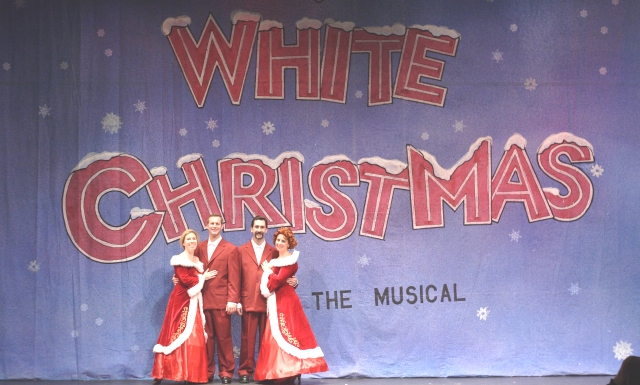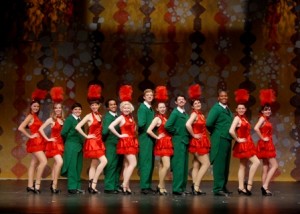I was at the “Beautiful” Levoy Theatre to see Irving Berlin’s WHITE CHRISTMAS. What a wonderful trip down memory lane! Of course, I wasn’t around at its conception, but I’ve loved Berlin’s music since I was a kid.
I’ve seen the movie, and fortunately, now I’ve seen the stage play. There are few differences. The play is a little longer, mostly because of scene changes. I can’t tell you what it was like on Broadway because I wasn’t there and I don’t know anyone who was, but I’m sure they had an army of production hands backstage, along with tons of room backstage. Now, you know I can look up what the critics said about Irving Berlin’s production and compare to this one, but it wouldn’t be fair, would it? I’m kidding, you know. You are probably assuming the play was produced in the 50s on Broadway. That couldn’t be farther from the truth. I was a babe when it was being produced…
Irving Berlin’s WHITE CHRISTMAS was actually based on the 1954 film, starring Bing Crosby and Danny Kaye, and it never saw Broadway until 2008. It began with an off-Broadway tour in 2004. It had a revival in 2009. Although the musical did receive a few Tony Award nominations, the critics thought it was just okay—probably too much like the 1954 film. The film, on the other hand, was a huge box office success, and the first film to use the wide-screen technology of VistaVision.
The Off Broad Street Players’ version was great, especially considering it wasn’t 1954, and they didn’t have film editing like the film, or an army of production people, and everybody knew how to tap dance. You learned it as a kid. Even boys. Don’t compare it to the film either. I won’t. Bing Crosby and Danny Kaye are gone now, but OBSP’s crooners were lively, funny and good singers in their own way. Thankfully none of the actors seemed to concentrate on the fact that this Christmas classic would be a tough act to follow.
Most actors, if there is a film version, don’t like to watch it before they do the role. The way this musical came to be unusual since they usually make the movie from the play. Now, they make films from video games. I’d like to see them make a play from a video game. Wait. That was a back-handed compliment. Well, video games are plays. I hope I redeemed myself. I know I have a delete key and I know how to use it.
Watching the film before or not, the actors’ focus was where it belonged. At each other and at us when appropriate. These actors were having fun. Okay, so the synchronized tap number was a little off some times. Those guys were in the back. I can’t tap. You? The orchestra was a little loud for the big tap number. Only a tap dancer would think so. And, how often do you suppose the orchestra plays to a mostly tap number? Still, it was interesting to watch. In fact most of the dance numbers came with the nostalgia I get from watching old musicals on television. To see it live was even better. Choreography had to be tough. I doubt very much the choreographer came from a generation that remembered that kind of dancing. I should tell you at this point at least that the performance I saw was before opening night and there were no programs at that time. That’s okay though. Everyone did well. From the director and the principals to the train conductor. I was mesmerized by the characters, the songs and the spirit.
I was all set to write about a Holiday show. That’s when the theatre gives back to the community holidays, and I don’t have to look at a production as serious theatre. I put my critic pen away. This production performed both functions extremely well, and so I treated this show like any other.
I liked the variety that was Irving Berlin; his music always a change from the norm and comparing to now—a special treat. The costumes and set were just enough. I am puzzled by one decision and I think I know why it was made, but I feel the need to pose the question anyway: Why was the fireplace set in front of a window? The audience will accept an empty space or a partial wall as a complete wall, but a window is a window and a fireplace does not go there. I understand it made for a nice Christmas feel center stage; however, moving it up stage left where there was an invisible wall would have worked as well. It would not have changed our focus. Christmas wreaths or other decorations could have been placed on the windows to raise the Christmas spirit quotient. Or, replacing the fireplace with the sofa that was down stage left and putting something else there during that scene. Everyone used a microphone so we would easily have heard the scene now placed center stage.
Some directors feel that to have the most attention, the actors must be center stage. I don’t agree. Often, if the action or significant objects are not centered, the audience wonders why and it draws the eye away from center stage, causing us to pay even closer attention.
Although I nitpicked a little, it was only to point out what I think were some logical considerations for another time perhaps. If you are looking for a little different Christmas or Holiday show, this is it. Older members of your family will appreciate Irving Berlin’s music and the dance numbers as well as the corny plot, typical of musicals of that period. I thought this was going to run all month, but I was wrong — it closes on November 24th, so be sure to get your tickets soon.
Irving Berlin’s WHITE CHRISTMAS
Libretto by David Ives
Music and Lyrics by Irving Berlin
Staged and Musically Directed by Walter Webster
Nov. 15, 16 at 8:00pm, Nov. 17 at 3:00 at 3:00pm
Nov. 21 at 7:30, Nov. 22, 23 at 8:00pm, Nov. 24 at 3:00pm
Off Broad Street Players
The Levoy Theatre
126-130 N. High Street
Millvile, NJ 08332
856-327-6400
http://www.obsp.org/white-christmas/



